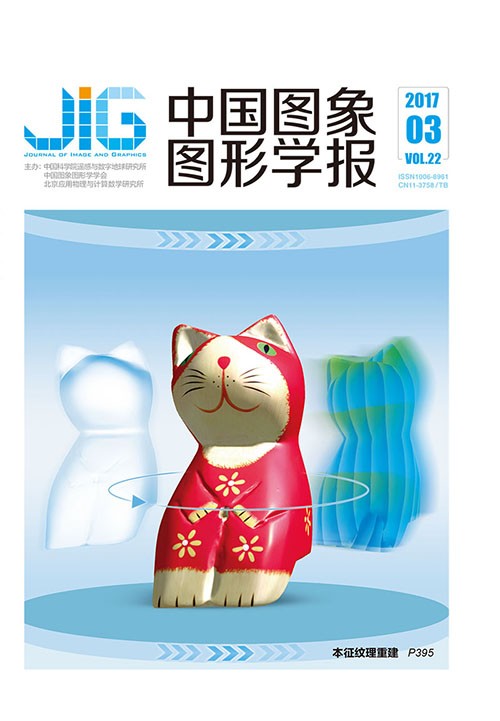
增强奇异值分解和细胞神经网络的零水印
摘 要
目的 针对奇异值分解算法存在的对角线失真、虚警错误等问题,引入一个寻找最抗攻击缩放比例的参数,提出基于增强奇异值分解的零水印算法。方法 首先将离散小波变换作用于原始图像,对分离出的低频逼近子图进行不重叠分块,对分块后的低频逼近子图作离散余弦变换得到低频系数矩阵,再分别对每个块矩阵进行增强奇异值分解,将得到的最大奇异值与最大奇异值均值作比较构成特征向量;然后对水印图像进行Arnold变换和Logistic映射得到置乱加密后的水印图像;最后将特征向量和置乱加密后的水印图像分别作为细胞神经网络的起始值和控制输入值,通过设定细胞神经网络的反馈模板、控制模板以及阈值来确定具体的可逆逻辑运算。经过可逆逻辑运算处理后的细胞神经网络输出图像即为零水印的注册图像。将注册图像保存到认证中心以证明对图像作品的版权。结果 在JPEG压缩、噪声、滤波、旋转以及剪切等各种攻击下,提取的水印和原始水印的归一化相关值都在96%以上,算法平均运行时间为2.389 s,性能较高。结论 通过利用参数对奇异值矩阵进行调整的方法,不仅增强了算法的鲁棒性,而且解决了奇异值分解(SVD)出现的对角线失真和虚警错误问题。同时通过结合零水印的思想,解决了传统水印算法需在载体图像中嵌入水印而导致的水印不可见性与鲁棒性之间的矛盾。
关键词
Zero-watermarking based on boost normed singular value decomposition and cellular neural network
Xiao Zhenjiu, Zhang Han, Chen Hong, Gao Ting(College of Software, Liaoning Technical University, Huludao 125105, China) Abstract
Objective Numerous illegal pirating sites and programs have emerged with the rapid development of digital network technology because digital media can be easily copied and tampered with. Digital watermarking technology, which is an effective solution to image copyright protection, content authentication, integrity, and other issues, has become a crucial research topic in recent years. The singular values of images received via singular value decomposition (SVD) are strongly resistant to various attacks. Therefore, scholars have proposed various SVD-based watermarking methods. We proposed the novel boost normed singular value decomposition (BN-SVD) to solve the problems of diagonal distortion and false positives, which are caused by SVD. The method involves establishing a parameter to identify the optimum scaling factor for efficient robustness to improve existing SVD algorithms. Considering the inconsistencies between invisibility and robustness caused by embedding watermarks in original images by traditional watermarking algorithms, a novel zero-watermarking scheme based on BN-SVD is proposed. Zero-watermarking is defined by the registration and certification processes. In registration, an algorithm uses the major characteristics of a digital image to construct zero-watermarking registration information. The information is stored in a centralized authentication center. In certification, the watermark information is restored by using the digital images to be certified and the data stored in a centralized authentication center.Methods First, a low-frequency approximation sub-graph was established from an original image that was decomposed by discrete wavelet transform (DWT) to non-overlapping image blocks. The low-frequency approximation sub-graph generated a low-frequency coefficient matrix via discrete cosine transform (DCT). BN-SVD was used to each block matrix to achieve a maximum singular value. A characteristic vector was created by comparing the maximum singular value with the average of the maximum singular value. The watermark image was disposed with Arnold transformation and Logistic map to obtain an encrypted and scrambling watermark image. Finally, the characteristic vector was set as an initial value and the scrambling encrypted watermark image as a controlling input value are both sent into a cellular neural network (CNN). By setting up a feedback template, the control template and threshold value of CNN determined the specific reversible logic operation. The output image was the registration image of zero-watermarking. The registration image was saved in the certification center to verify the copyright of the image.Results Experimental results indicated that all watermark images extracted by the proposed method do not exhibit diagonal marks when heterogenic attacks are imposed on original images. The proposed method overcame the diagonal distortion problem in the diagonal experiment. A one-to-one relation between the singular value vector and the image was established by introducing a parameter where different images have various singular value vectors. Therefore, the major characteristic of different images can be represented by different singular value vectors in a false-positive rate experiment. The normalized correlation between the extracted watermark image from BN-SVD and the original watermark image was below 50%. A low false-positive rate was observed. In the robustness experiment, we imposed various types of attacks, including JPEG compression, noise, filtering, rotating, and shear on the images. In the JPEG compression attack, the normalized correlation reached up to 99%. In the noise attack, the normalized correlation exceeded 97%. In the filter attack, the normalized correlation exceeded 98%. In the rotating attack, the normalized correlation was higher than 96%. In the shear attack, the normalized correlation exceeded 98%. These results indicated the need to improve high-shear attacks.Conclusion A parameter will be used to modify the singular values of a matrix, which enhances the robustness of the algorithm and eliminates the false-positive and diagonal distortion problems of SVD. Introducing CNN is advantageous because the attacker cannot determine specific parameters. Therefore, the attacker extract the watermark image by reversible logic operation to improve the security of the watermarking. The parallel image processing of CNN can be achieved with hardware, which makes the algorithm applicable in occasions with higher real-time requirement.
Keywords
Arnold transform boost normed singular value decomposition (BN-SVD) cellular neural network (CNN) discrete wavelet transform (DWT) discrete cosine transform (DCT) Logistic map zero-watermarking
|



 中国图象图形学报 │ 京ICP备05080539号-4 │ 本系统由
中国图象图形学报 │ 京ICP备05080539号-4 │ 本系统由